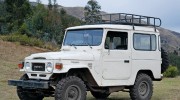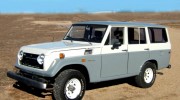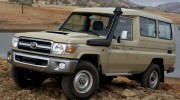
There was play, or at least sport, as well as work: In 1974 a nearly stock FJ40 won the grueling Baja 1000 off-road race. Its sole modification involved its conversion for the use of propane, instead of gasoline, as fuel.
As the Land Cruiser’s reputation grew, so too did the demand for it. As a result, by 1977 a half-million Land Cruisers had hit roads and trails everywhere. But time was closing in on the 40 Series, and also on the 55 Series. For all the refinement it had received over its life span, the 40 Series remained fairly Spartan. So 1983 was its final year of sales in the U.S. Production of the 55 Series ceased in 1979. Sales numbers, meanwhile, continued to reflect the popularity and success of the Land Cruiser name. By 1980, 1,000,000 had been sold.
Meanwhile, Land Cruiser four-wheel-drive technology was expanding into other Toyota lines. Most notable was the first 4×4 compact truck in the U.S., introduced by Toyota in 1979. The compact Toyota pickup, equipped with its unbeatable 4×4 drivetrain, remained the best selling compact 4×4 in the U.S. market for the next 14 years. In 1984 the popular 4Runner, developed from the 4×4 pickup chassis, was introduced. Highlighting its Land Cruiser genetics, it was built at the Araco Corp. plant in Toyota City, Japan, the home of Land Cruiser production.
Land Cruisers, meanwhile, rolled on. The Land Cruiser 60 Series appeared in 1980 to replace the 55 Series. Production continued through 1989 and owners found that not only did this larger, more commodious Land Cruiser continue to uphold the brand’s ability to cover rough ground, but that with basic maintenance, an FJ60 easily would rack up hundreds of thousands of miles.
As 60 Series sales were growing, the Land Cruiser FJ40, discontinued in the U.S. in 1979, was coming to the end of its road in the rest of the world. While some segments of the worldwide 4×4 market continued to demand heavy-duty vehicles, others, especially recreational users, made it clear they wanted a vehicle that offered a bit more comfort than the 40 Series offered. Against these conflicting notions and with very little in the way of a final flourish, Land Cruiser 40 Series production ceased in late 1984. The trusty old 40 Series immediately was replaced by the much more modern 70 Series, production of which continues.
The basic Land Cruiser 70 Series had the two doors, solid axles and leaf springs of the 40 Series, and it was engineered to be just as tough and durable as the 40 Series, but it received a five-speed transmission and rode upon a 91-inch wheelbase a four-door version received a 107-inch wheelbase. More important, its interior was much more commodious than that of the 40 Series. It was built in a variety of types and styles, each specific to its market and the needs of its buyers.
The 60 Series wagon, meanwhile, underwent a complete makeover in 1989. It became the 80 Series. This happened after company product planners noticed the 60 Series increasingly was being used as a family vehicle. Owners wanted off-road capabilities for active family weekends, but they also wanted the comfort and practicality of a family sedan during the week.
The Land Cruiser 80 Series met those needs. With its launch in 1990, owners could enjoy a comfortable ride, thanks to coil springs up front, as well as to leather-trim seats, air conditioning, entertainment systems and mobile communications. Safety also became more important with the adoption of airbags and ABS braking systems.
By 1990, it had sold 2 million Land Cruisers worldwide.
In 1993, the 80 Series Land Cruiser was upgraded with a 24-valve, DOHC inline six-cylinder engine displacing 4.5L (274.6 c.i.). This engine produced 212 horsepower and 275 pound-feet of torque, and was more than capable of pulling Land Cruiser’s 5,153 pounds of curb weight. The 80 Series Land Cruiser, with its smooth ride and comfortable interior, seemed a long way from the FJ40 paradigm. But when pointed down a rough trail, it displayed the same competence and reliability that helped the FJ40 cement the Land Cruiser name into the public consciousness.
For the 1996 model year, Toyota launched a third Land Cruiser line, to be sold alongside the 70 and 80 Series Land Cruisers. This was the Land Cruiser 90 Series, also known as the Prado. The 90 Series was an evolutionary branch of the 70 Series. It therefore offered Land Cruiser’s legendary capabilities, both on the highway and off the road. But it was enhanced by independent front suspension and coil springs in place of the solid front axle and leaf springs that had provided suspension for so long. It also offered available fulltime four-wheel drive with a locking center differential, a four-speed automatic transmission, stability control and traction control. The appeal of the Prado/90 Series was so great, and the demand so intense, that following its introduction, the Tahara plant, in which it was built, operated 24 hours a day for six months straight.
It was this line that in 2002 was developed into the Land Cruiser 120 Series, which includes the current 4Runner and Lexus GX470, which are not marketed in the U.S. as Land Cruisers, but which share and benefit from Land Cruiser philosophy and four-wheel-drive technology. And, in an interesting bit of family planning, the 120 Series provides the foundation of the FJ Cruiser.

Beginning in 1998 the luxurious Land Cruiser 100 Series replaced the 80 Series. It was larger, structurally more solid and substantially more powerful than its predecessor. It featured the first V8 engine in a Toyota vehicle, a 4.7L 32-valve DOHC producing 235 hp. For the 2006 model year, that figure reached 275 hp. Plush though it may be, the 100 Series retains its Land Cruiser credentials. For instance, it still has 80 percent of its torque available at 1,100 rpm, and it still has the steep approach and departure angles required for rough-country travel. But it also has high-tech touches like stability control, anti-lock brakes and automatic vehicle height adjustment.
So there they are the roots and branches of the Toyota Land Cruiser family tree. The tree developed an amazing variety of branches, and each branch was fruitful. It bore that original BJ and a long line of descendants that include not only the fabled FJ40 and every Toyota 4×4 pickup, but also a well-developed line of capable, comfortable Land Cruisers and their upscale Lexus 4×4 siblings and, finally, the new 2007 FJ Cruiser, a vehicle that carries within it the technological DNA of that first Land Cruiser.
Of course, the long-running Land Cruiser 100 series












